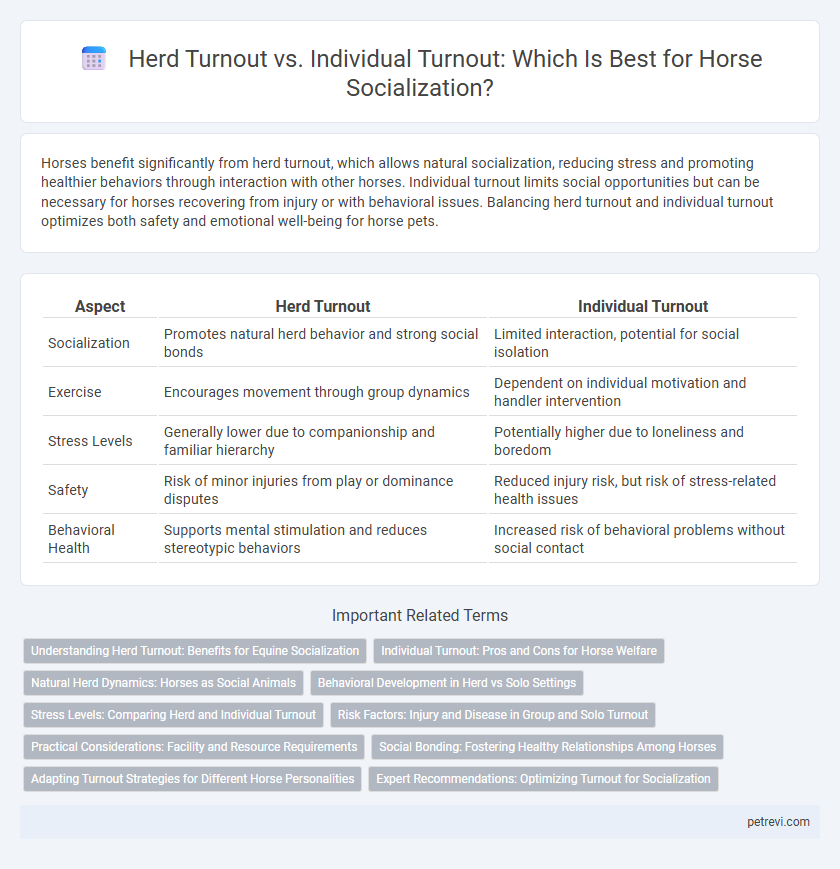Horses benefit significantly from herd turnout, which allows natural socialization, reducing stress and promoting healthier behaviors through interaction with other horses. Individual turnout limits social opportunities but can be necessary for horses recovering from injury or with behavioral issues. Balancing herd turnout and individual turnout optimizes both safety and emotional well-being for horse pets.
Table of Comparison
| Aspect | Herd Turnout | Individual Turnout |
|---|---|---|
| Socialization | Promotes natural herd behavior and strong social bonds | Limited interaction, potential for social isolation |
| Exercise | Encourages movement through group dynamics | Dependent on individual motivation and handler intervention |
| Stress Levels | Generally lower due to companionship and familiar hierarchy | Potentially higher due to loneliness and boredom |
| Safety | Risk of minor injuries from play or dominance disputes | Reduced injury risk, but risk of stress-related health issues |
| Behavioral Health | Supports mental stimulation and reduces stereotypic behaviors | Increased risk of behavioral problems without social contact |
Understanding Herd Turnout: Benefits for Equine Socialization
Herd turnout promotes natural equine socialization by allowing horses to engage in essential behaviors such as grooming, playing, and establishing social hierarchies within a group setting. This environment reduces stress and encourages mental stimulation, leading to improved overall well-being and reduced behavioral issues compared to individual turnout. Access to a dynamic social structure in herd turnout supports horses' psychological health and fosters stronger, more balanced social bonds.
Individual Turnout: Pros and Cons for Horse Welfare
Individual turnout allows horses to rest and recover without competition or stress from herd dynamics, promoting physical healing and mental relaxation. However, isolation can lead to social deprivation, increasing risks of behavioral issues such as cribbing or anxiety due to lack of interaction with other horses. Properly managed individual turnout requires enrichment and regular social contact to balance welfare needs and minimize loneliness.
Natural Herd Dynamics: Horses as Social Animals
Horses naturally thrive in herd turnout, which supports their social instincts and mimics wild herd dynamics that promote bonding, hierarchy establishment, and stress reduction. Individual turnout limits these interactions, potentially leading to loneliness and behavioral issues due to the lack of natural social cues and companionship. Providing herd turnout aligns with the horse's inherent need for constant social engagement and natural movement patterns essential for mental and physical well-being.
Behavioral Development in Herd vs Solo Settings
Horses exhibit more natural social behaviors and reduced stress levels when in herd turnout compared to individual turnout, promoting healthier behavioral development. Herd settings enable horses to establish social hierarchies, engage in mutual grooming, and practice communication skills vital for psychological well-being. Solo turnout limits these interactions, often leading to boredom, increased anxiety, and potential development of stereotypic behaviors.
Stress Levels: Comparing Herd and Individual Turnout
Horses turned out in a herd exhibit significantly lower stress levels due to natural social interactions and established hierarchies that provide comfort and reduce anxiety. Individual turnout often increases stress markers such as elevated cortisol levels and pacing behaviors, reflecting social isolation and boredom. Optimal equine welfare is achieved by prioritizing herd turnout to promote relaxation and psychological well-being.
Risk Factors: Injury and Disease in Group and Solo Turnout
Herd turnout promotes natural horse socialization but increases risk factors such as injuries from fighting or accidental trampling, as well as disease transmission through close contact and shared resources like water and feed. Individual turnout reduces direct social interaction and the likelihood of injury from aggressive behaviors but can lead to stress-related behaviors and may limit immune system strength due to reduced exposure to common pathogens. Balancing turnout strategies requires careful management to minimize injury risks and implement robust biosecurity practices to control disease spread within groups.
Practical Considerations: Facility and Resource Requirements
Herd turnout for horse socialization demands larger paddocks equipped with multiple water sources, varied grazing areas, and secure fencing to accommodate group dynamics and reduce stress. Individual turnout requires smaller, well-maintained enclosures with adequate shelter and easy access to feed, minimizing resource competition and allowing for focused monitoring of each horse's health. Proper facility design and resource allocation are critical to balance social interaction benefits with management practicalities and safety concerns.
Social Bonding: Fostering Healthy Relationships Among Horses
Herd turnout significantly enhances social bonding by allowing horses to engage in natural interactions such as mutual grooming, play, and establishing hierarchies, which are essential for mental well-being and stress reduction. Individual turnout limits these social opportunities, potentially leading to isolation and behavioral issues due to the lack of peer interaction. Sustained herd dynamics promote healthier relationships, improving overall horse welfare through consistent companionship and social learning.
Adapting Turnout Strategies for Different Horse Personalities
Horses exhibit diverse social behaviors influenced by individual temperaments, making tailored turnout strategies essential for optimal socialization and welfare. Herd turnout promotes natural interactions and hierarchy establishment, benefiting sociable or younger horses, while individual turnout suits more anxious or aggressive horses to prevent stress and injury. Adjusting turnout methods based on each horse's personality enhances mental health, reduces vices, and supports physical well-being.
Expert Recommendations: Optimizing Turnout for Socialization
Experts recommend herd turnout over individual turnout for optimal horse socialization, emphasizing the importance of natural herd dynamics in promoting mental well-being and reducing stress. Herd turnout allows horses to engage in essential social behaviors such as grooming, play, and establishing hierarchy, which are vital for psychological health. Individual turnout should be minimized and used selectively to prevent isolation-induced anxiety and promote balanced social interactions within a safe environment.
Herd Turnout vs Individual Turnout for Horse Socialization Infographic

 petrevi.com
petrevi.com